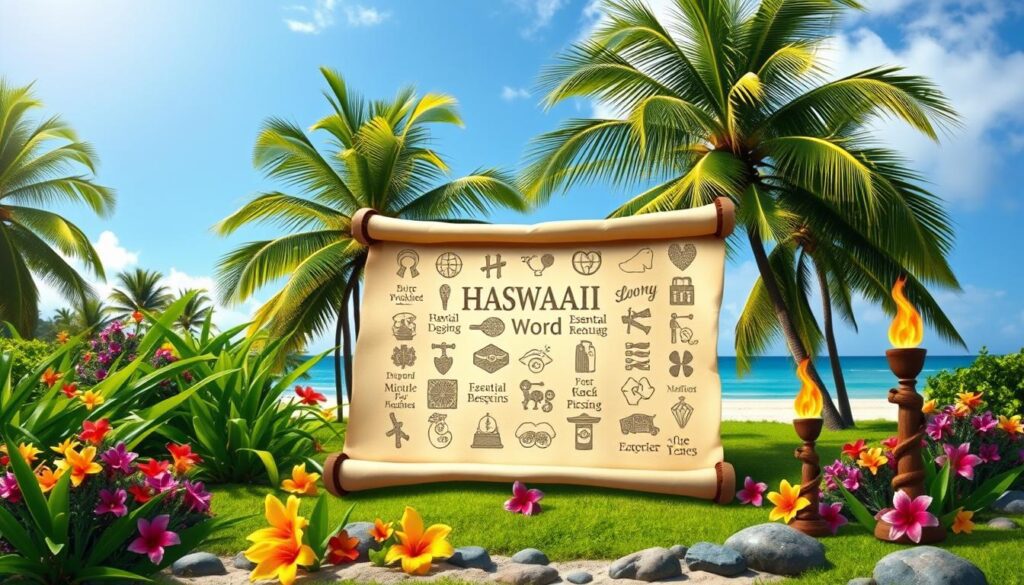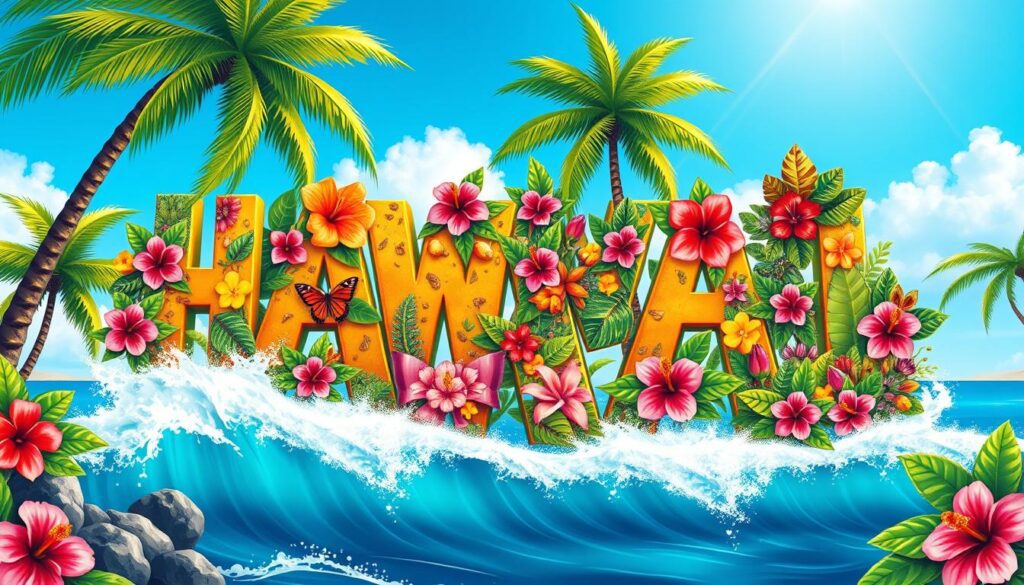Before you step onto the warm island sand, let the fragrant ocean breezes carry you away. Learning a few Hawaiian phrases can make your Hawaii travel experience even more special. This article will guide you through essential Hawaiian words and phrases every traveler should know. You’ll learn how to pronounce beautiful Hawaiian words like a local and gain insight into the language’s history and culture.
Discover phrases that reflect the Hawaiian way of life, emphasizing balance and harmony. These words and phrases will help you understand the significance of ʻōlelo Hawaiʻi (Hawaiian) in the islands.
Key Takeaways
- Discover essential Hawaiian words and phrases to enrich your Hawaii vacation experience.
- Learn how to pronounce Hawaiian words and phrases like a local.
- Gain insight into the history and culture behind the Hawaiian language.
- Explore Hawaiian language phrases that promote a balanced and harmonious way of living.
- Understand the resurgence of the Hawaiian language and its importance in the islands.
Embrace the Spirit of Aloha
Hawaii is more than a destination for beach vacations or adventure tours. It’s a place where the spirit of aloha, a profound Hawaiian concept, fills every aspect of life. Aloha, a word that means love, compassion, and respect, is the islands’ heartbeat.
Aloha: A Hawaiian Word for Love
Aloha is a way of being that encourages kindness and empathy. It’s a greeting that goes beyond “hello” or “goodbye.” It reminds us to cherish our connections and approach life with an open heart. Exploring Honolulu’s hotels and flights reveals the spirit of aloha, from warm welcomes to genuine hospitality.
Mahalo Nui Loa: A Lesson in Gratitude
Mahalo, the Hawaiian word for “thank you,” is more than a polite expression. It’s a way of life that teaches constant gratitude. Mahalo nui loa, meaning “thank you very much,” is a heartfelt acknowledgment of the gifts and blessings we receive. Whether it’s Maui’s stunning landscapes or the kindness of people, embracing this spirit of gratitude deepens our appreciation for the world and our connections.
The essence of aloha and mahalo nui loa reflects Hawaii’s rich cultural heritage. As you plan your beach vacations, adventure tours, or hotel stays, embrace these timeless Hawaiian values. Let them enrich your island getaway.
Reclaiming the Hawaiian Language
The Hawaiian language’s history and resilience mirror the Hawaiian people’s enduring spirit. Colonization and American annexation led to laws banning its use. Yet, in the 1970s, a movement against language and cultural decline emerged. This movement led to Hawaiian being recognized as an official language.
A Historical Context for Reclaiming the Hawaiian Language
In the 1980s, only elders could speak Hawaiian fluently. Fewer than 50 children could converse in it. Recently, laws banning Hawaiian teaching were overturned. Now, school children can learn their native tongue.
This effort to reclaim the language shows the Hawaiian people’s determination and resilience. They fought to preserve their cultural identity despite historical suppression.
Today, the Hawaiian language is experiencing a revival. More people, including native Hawaiians and visitors, are learning and using it. This renewed interest celebrates the islands’ rich cultural heritage. It also allows travelers to connect more deeply with Aloha during their Big Island getaways or Hawaiian cruise vacation packages.
Useful Hawaiian Words for Travelers

While you don’t need to be fluent in Ōlelo Hawai’i to enjoy your time in the Hawaiian islands, learning a few key words can greatly enhance your travel experience. From understanding local customs to navigating the stunning Waikiki beach resorts or Luxury Hawaii honeymoon packages, a little Hawaiian language can go a long way.
Here are some essential Hawaiian words and phrases that every traveler should know:
- Mauka – Toward the mountains or inland
- Makai – Toward the ocean
- Kapu – Taboo, meaning “keep out” or “no trespassing”
- Lua – Hole, meaning bathroom
- Wahine – Woman
- Kane – Male
- Haole – Foreigner, commonly referring to a white person
- Kama’aina – Native Hawaiian or local
- Ohana – Family or community
Mastering even a few of these Hawaiian words and phrases can help you connect with the local culture and make the most of your Waikiki beach resorts or Luxury Hawaii honeymoon package experience.
| Hawaiian Word | Meaning |
|---|---|
| Aloha | Hello, goodbye, and love |
| Mahalo | Thank you |
| Keiki | Children |
| Ono | Delicious |
| Poke | Cubed, seasoned raw fish |
| Honu | Hawaiian green sea turtle |
By incorporating these useful Hawaiian words into your travel vocabulary, you’ll be able to better navigate your Waikiki beach resorts or Luxury Hawaii honeymoon package experience and connect with the rich cultural heritage of the islands.
Hawaii vacation packages: Enrich Your Island Getaway
Dive into the enchanting beauty of the Hawaiian Islands with expertly crafted vacation packages. These deals take you from Kauai’s lush landscapes to Maui’s sun-kissed beaches. They offer a smooth way to discover Hawaii’s natural splendor and cultural depth.
Hawaii family vacations start at $543 per person, double occupancy. Resort packages begin at $943 per person. For a lavish honeymoon, prices range from $943 to $1,537 per person, double occupancy. This ensures a lavish experience.
Many visitors stick to Oahu, but Hawaii has much more to offer. Kauai, Maui, Molokai, and the Big Island of Hawaii are full of adventures. From volcano hikes to peaceful nature trails, there’s something for everyone. With flights under an hour between islands, exploring is easy.
These vacation packages last from 6 to 11 nights. You can customize your stay on each island. They include airfare, accommodations, rental cars, meals, and activities like volcano exploration, surfing, or cultural experiences.
Looking for a family vacation, a romantic honeymoon, or an island adventure? These packages offer a seamless and enriching way to experience Aloha.
Mastering the Hawaiian Alphabet

Exploring Oahu resort packages or Maui beach vacations becomes more enriching when you delve into the Hawaiian language. The Hawaiian alphabet, or “ka pīʻāpā Hawaiʻi,” bears some resemblance to English. This is due to its development with the aid of Western missionaries.
Hawaiian Vowels
The five vowels in Hawaiian – A, E, I, O, and U – may seem familiar at first glance. However, their pronunciation differs slightly. A line above the vowel, known as a kahakō, signals to lengthen the sound. For instance, “Maui” is pronounced as “Mah-OO-ee,” with the “a” and “u” sounds extended.
Hawaiian Consonants
The Hawaiian alphabet includes consonants like H, K, L, M, N, P, and W, which are familiar to English speakers. Yet, it introduces the ‘okina, a symbol for a glottal stop. This new sound, combined with the vowels, creates a musical language that mirrors the Pacific’s rhythms.
Learning the Hawaiian alphabet is a fulfilling journey into the cultural heritage of the Hawaiian Islands. Whether you’re booking an Oahu resort package or a Maui beach vacation, mastering its unique sounds enhances your appreciation for the Hawaiian language’s beauty and complexity.
Understanding Hawaiian Pidgin
Visiting Hawaii, you’ll encounter a unique language blend of Hawaiian, English, Portuguese, Filipino, Chinese, and Japanese. Known as Hawaiian Pidgin or Pidgin English, it emerged in the 1800s. It was a communication tool for the diverse workforce on Hawaiian sugarcane plantations.
Today, Pidgin is a cornerstone of local culture, especially outside Oahu’s tourist areas. It’s a creole language, with its own grammar, vocabulary, and cultural identity. A common Pidgin term, “da kine,” can refer to almost anything.
| Pidgin Word | Meaning |
|---|---|
| Brah | Brother |
| Choke | A lot |
| Da kine | The kind, anything |
| Grind | To eat |
| Shaka | A gesture of goodwill |
| Shoyu | Soy sauce |
| Stay | Is/to be |
| Try | Please, do |
Pidgin’s unique pronunciation distinguishes it, with dropped “th” sounds and “r” sounds after vowels. “L” sounds at the end become “o.” This colorful language showcases the islands’ diverse cultural heritage. It’s a key part of the local experience.
Whether you’re on Kauai adventure tours or exploring Honolulu, learning Hawaiian Pidgin enhances your connection with the islands. Embrace the local language and enjoy the delicious Hawaiian cuisine during your stay.
Common Hawaiian Phrases to Know
Visiting the Hawaiian islands means encountering a wealth of common phrases that showcase the rich culture and language. Beyond the familiar “aloha” and “mahalo,” there are many other terms and expressions. These can greatly enhance your Big Island getaways or Hawaiian cruise vacation packages.
“Aloha” is a versatile word used to greet, bid farewell, or express love and compassion. “Mahalo” goes beyond a simple “thank you,” conveying deep gratitude and respect. Mastering these phrases allows you to connect with locals and fully immerse yourself in the spirit of aloha.
Phrases like “makai” (towards the ocean) and “mauka” (towards the mountains) are useful for navigating Kauai’s diverse landscapes. “Pau hana” signifies the end of the workday, reflecting Hawaii’s relaxed atmosphere.
| Hawaiian Phrase | Meaning | Pronunciation |
|---|---|---|
| Aloha | Hello, Goodbye, Love, Compassion | Ah-loh-hah |
| Mahalo | Thank you | Mah-hah-loh |
| Makai | Towards the ocean | Mah-kye |
| Mauka | Towards the mountains | Mah-oo-kah |
| Pau Hana | End of the workday | Pow Hah-nah |
| Kane | Man | Kah-neh |
| Wahine | Woman | Wah-hee-neh |
| Keiki | Child | Keh-ee-kee |
| Kapu | Taboo, Forbidden, Sacred | Kah-poo |
| Ono | Delicious | Oh-no |
By learning these common Hawaiian phrases, you can deepen your cultural understanding and forge meaningful connections. Immersing yourself in the local language enriches your experience, whether on a Hawaiian cruise vacation package or a Big Island getaway.
Hawaiian Proverbs and Sayings
The preservation of Hawaiian heritage is a testament to the kupuna (elders), like Mary Kawena Pukui. She authored ʻŌlelo Noʻeau, a collection of proverbs. These sayings, rich in poetry and wisdom, teach us how to live and find balance.
View the World With Love
The phrase ʻAʻohe loa i ka hana a ke aloha (No task is too big when done with love) teaches us to approach life with an aloha spirit. It emphasizes the importance of love in our daily endeavors.
Live in Harmony with Nature
The saying ʻAʻohe i hāʻawi mai i ka lehua ʻaʻe kekahi (No one can claim the lehua blossom for oneself alone) highlights our role as stewards of nature. It encourages us to live in harmony, not as owners.
We are Stronger Together
The phrase ʻAʻohe hana nui ke alu ʻia (No task is too great when undertaken together) underscores the power of unity. It reminds us that together, we are invincible.
These Hawaiian proverbs and sayings offer timeless wisdom. They invite visitors to Waikiki beach resorts and Luxury Hawaii honeymoon packages to embrace the aloha spirit. They encourage a deep connection with the islands’ rich cultural heritage.
Celebrating the Hawaiian Language Revival
Hawaii is witnessing a surge in native Hawaiian language speakers. Laws banning its teaching have been lifted, enabling school children to learn their ancestral heritage. This resurgence is a form of resistance and renewal, as the Hawaiian people reclaim their rich culture and revive ancestral knowledge.
The Hawaiian language is the most studied Native American language and the only one used by a state government. February is celebrated as Hawaiian Language Month, with events and initiatives to promote and support ‘ōlelo Hawai’i. In 2012, the Hawai’i State Legislature formally declared February as ”Ōlelo Hawai’i Month, recognizing the importance of preserving this cultural treasure.
Preserving the Hawaiian language is vital for honoring tradition and strengthening cultural bonds. Efforts to revitalize the language have been ongoing since the 1980s, with the establishment of Hawaiian language immersion education programs like Pūnana Leo. Today, there are over 26,000 self-identified ʻōlelo Hawaiʻi speakers, and more than 798,000 users worldwide are learning Hawaiian on the Duolingo language app.
Celebrating events like Mahina ‘Ōlelo Hawai’i and Makahiki Season helps maintain a connection to Hawaiian history and encourages language use in daily life. Nonprofits like Kauluakalana, founded in 2019, actively support preserving Hawaiian language and culture. Online resources like wehewehe.org provide accessible Hawaiian word references.
The resurgence of the Hawaiian language showcases the resilience and determination of the Hawaiian people. By reclaiming their native tongue, they preserve their cultural heritage and inspire pride among residents and visitors. Whether exploring Honolulu hotel and flights or enjoying a getaway to the Big Island, experiencing the Hawaiian language is essential for connecting with Hawai’i’s true essence.
Essential Hawaiian Vocabulary for Fun Activities
Planning a Hawaii vacation, whether it’s a luxurious honeymoon or a family trip, requires knowing essential Hawaiian vocabulary. Learning terms like “lū’au” (a traditional event with hula dancing and a buffet), “hula” (the iconic Hawaiian dance), and dishes like “poi” (pounded taro), “poke” (raw seafood), and “Spam Musubi” (savory snack) enriches your experience. These words help you appreciate and engage with Hawaii’s rich cultural heritage.
Hawaii’s culinary diversity and vibrant traditions offer many ways to dive into local life. Understanding these key terms allows you to explore Waikiki beach resorts and luxury honeymoon packages with a deeper appreciation. Embracing the local language leads to more meaningful interactions, a better grasp of Hawaiian lifestyle, and unforgettable memories.
Whether at a lū’au, exploring beaches, or enjoying traditional dishes, knowing Hawaiian vocabulary enhances your travel experience. It fosters a deeper connection with the local culture, making your island getaway even more memorable.

Scott Sweeney is the creator of Virtual Hawaii 360. Scott is a professional marketer and a lifelong Hawaii enthusiast. Scott splits time between Oahu and Dayton, Ohio. In addition to his marketing endevours, he is also a published Ukulele musician.
